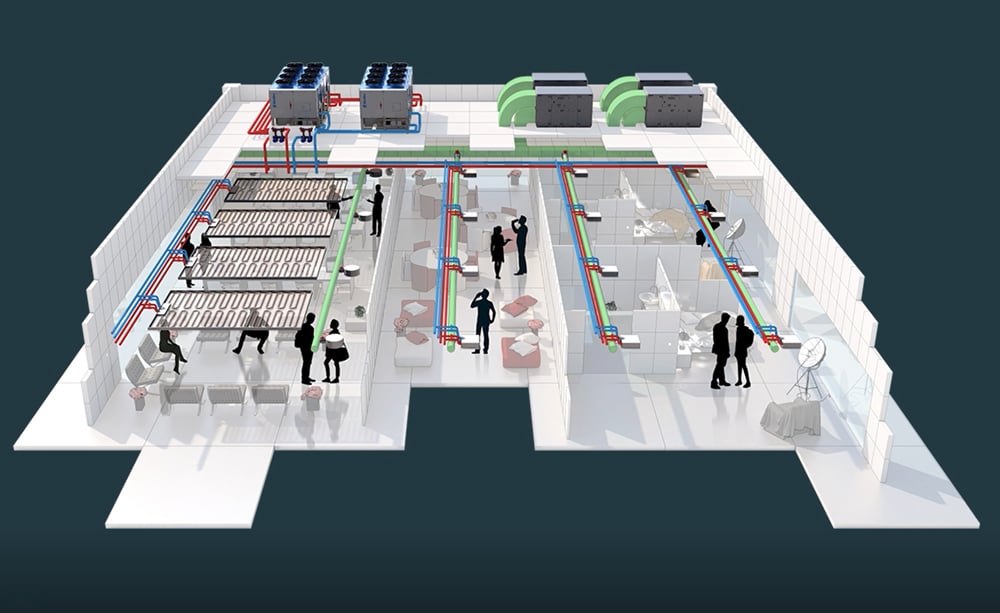At the end of May, Swegon broadcast a series of digital live events in different languages called The Industry Challenge. We did this to address the growing demands and expectations which we in the indoor climate business need to manage.
A recent study shows that between 30 and 40 percent of employees have symptoms like headache or attention problems at work. At the same time, we need to think more sustainable and decrease our carbon footprint. This is a challenge for the entire industry, affecting everything from product development to how we operate.
Human, building, planet
Swegon’s holistic approach to the Industry Challenge consists of three parts - Human, Building and Planet – and by addressing them together, we can move towards a solution.
The Human aspect is the health and wellbeing of the people living or working inside the buildings.
The Buildings themselves are complicated matters. Customer adaptations and changes in usage over time puts high demand on the flexibility on the solutions. More recently IT security has also become an issue, as connectivity is sometimes applied in a patchwork fashion.
And as for the Planet aspect, buildings are responsible for 40 percent of the world’s CO2 emissions, both from the building materials and from the energy consumed over time. We as suppliers have a huge responsibility here and we need to make sure there is a low energy usage from our products and solutions.
It is imperative that we do not address these challenges one by one in sequence, but that we address them as parts of the same challenge, to ensure a healthy, economically viable and sustainable solution.
Stepping up to the challenge
So, how do we solve this? In short: with a system approach. Instead of looking at each product and service separately, we need to make sure it all works together to achieve a low lifecycle cost. By measuring and demand-controlling the indoor environment we can create a healthy indoor climate with the lowest possible energy consumption.
Human, building, planet
Swegon’s holistic approach to the Industry Challenge consists of three parts - Human, Building and Planet – and by addressing them together, we can move towards a solution.
The Human aspect is the health and wellbeing of the people living or working inside the buildings.
The Buildings themselves are complicated matters. Customer adaptations and changes in usage over time puts high demand on the flexibility on the solutions. More recently IT security has also become an issue, as connectivity is sometimes applied in a patchwork fashion.
And as for the Planet aspect, buildings are responsible for 40 percent of the world’s CO2 emissions, both from the building materials and from the energy consumed over time. We as suppliers have a huge responsibility here and we need to make sure there is a low energy usage from our products and solutions.
It is imperative that we do not address these challenges one by one in sequence, but that we address them as parts of the same challenge, to ensure a healthy, economically viable and sustainable solution.
Stepping up to the challenge
So, how do we solve this? In short: with a system approach. Instead of looking at each product and service separately, we need to make sure it all works together to achieve a low lifecycle cost. By measuring and demand-controlling the indoor environment we can create a healthy indoor climate with the lowest possible energy consumption.

Illustration of a Swegon system
To do this we need better tools in our toolbox to interact with, and manage, the building. The data collected with connected devises enable us to create algorithms to optimize energy performance and indoor climate. An example is the Swegon WISE system, which has already been able to adjust the indoor climate to the actual need of the building at any given moment with optimized airflows. With a newly added feature – water optimization – data input from the room can be connected to the heating and cooling of the building, resulting in a further decrease in energy consumption of up to fifteen percent.
But this is not enough, we also need to get to the next level, beyond optimized products. We need to collect information from outside the system, such as weather predictions and cost of electricity. By combining this information with data from the products we can create smarter buildings and develop smarter products. For example, the new mobile device app Swegon Inside is enabling the customers to “see” and determine the quality of the indoor environment. This increases the knowledge and awareness of the surrounding indoor climate, insights which are fundamental if we want to drive change. Visualising the invisible is the key for the future.





-Aug-16-2023-12-30-41-3641-PM.png?width=75&name=MicrosoftTeams-image%20(3)-Aug-16-2023-12-30-41-3641-PM.png)






.jpg?width=75&name=sigvardsson_220628_0008_small_webb%20(1).jpg)












.jpg?width=75&name=magnus%20andersson_550x550%20(1).jpg)











-4.png?width=75&name=MicrosoftTeams-image%20(3)-4.png)











